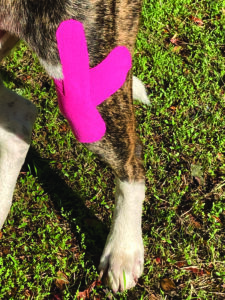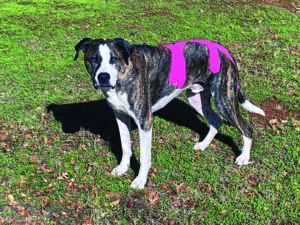If you pay attention to sports, you know that athletes around the world are wearing colorful tape on their arms, legs, shoulders, and torsos as part of treatments to heal muscle sprains, prevent injuries, relieve pain, and enhance performance.
Kinesiology tape, which was developed in the late 1970s by chiropractor Kenzo Kase, D.C., gained an international audience when Dr. Kase donated Kinesio Tape to the 2008 Bejing Summer Olympics. Taping looked strange then, but it’s commonplace now wherever athletes compete. And the athletes aren’t all humans, for taping has become popular for horses, dogs, and other animals. Might taping make a difference for your pup?
Also known as elastic therapeutic tape or kinesiology therapeutic tape, kinesiology tape is made of thin elastic cotton with an acrylic adhesive. The combination of stretch and adhesion makes kinesiology tape different from elastic bandages that treat injuries by reducing blood flow and applying pressure to prevent swelling. Instead of restricting movement, kinesiology tape moves with the body and, unlike elastic bandages, it can be left in place for days at a time.
Kinesiology tape is stretched as it’s applied, so once in place it contracts like a rubber band that pulls the skin, an action said to create more space for the flow of blood and lymph, speeding healing by increasing circulation.
Does Kinesiology Taping Work?
These are early days in taping research, and the evidence so far is inconclusive. PubMed (pubmed.ncbi.nlm.nih.gov) cites more than 200 clinical trials that tested kinesiology taping on humans, most of which concluded that the tape did little to improve sports performance, prevent injuries, relieve pain, or improve proprioception, strength, flexibility, circulation, blood flow, or lymphatic drainage, all of which are commonly made claims. All of the studies were small – and none involved dogs.
This lack of evidence hasn’t prevented some advertisers from making dramatic, exaggerated claims, so it’s worth remembering that kinesiology taping is not a magic cure-all, it doesn’t work for everyone, and it isn’t a substitute for veterinary diagnosis and treatment.
At the same time, veterinarians, canine rehabilitation therapists, and canine massage therapists who routinely use kinesiology tape report that many of their patients improve as a result. Taping is easily incorporated into other hands-on treatments, most dogs quickly adapt to it, and it can be done at home by family members between treatment visits.
Angelique Barbara, D.C., a chiropractor for humans whose training includes a bachelor’s degree in veterinary science and a master’s in veterinary pathobiology, specializes in hands-on treatments for dogs and horses. Her online program for health-care professionals and pet owners includes courses in canine kinesiology taping (see holisticanimalstudies.org).
“I think kinesiology tape is a fantastic modality that is currently underutilized with animals,” says Dr. Barbara. “I would love to see it become more mainstream with pet owners. Animals respond really well to taping, and it can provide them with a form of natural pain relief and provide them with support that can help them heal faster and prevent injuries in healthy pets.”

HOW TO USE KINESIOLOGY TAPE
Most kinesiology tape is two inches wide and sold in a 13- to 16-foot roll or precut in various shapes and sizes. While convenient for human athletes, precut shapes seldom match canine anatomy, so a two-inch roll may work well for you and your dog. The tape is sold in different adhesive strengths and stretch capacities, which makes for a confusing marketplace. Some brands are labeled specifically for dogs or horses, but brands sold for human use often work well for dogs. One challenges in taping dogs is their furry coats, so consider tapes labeled extra-sticky or for use with horses, and if your dog swims, look for water-resistant tapes.
“It is important for dog owners to familiarize themselves with kinesiology tape before attempting to tape their dogs,” says Dr. Barbara. “There are specific ways to cut and handle the tape that will facilitate the application process. The more hands-on time they have with the tape, the better the experience will be. The great thing about kinesiology tape is that it is a really safe modality and if you do not get the application you wanted right away, you can remove the tape and try again.”
Armed with a roll or piece of kinesiology tape, practice cutting the basic treatment shapes with non-stick scissors. (The adhesive can collect on regular scissors and interfere with cutting.) Start by rounding the ends, removing sharp corners. The length of your strips will depend on your dog’s size and the area being treated.
- The “I” Strip is a single piece of tape with rounded edges. An “I” strip can serve as an anchor if placed across another piece of tape, reinforcing and holding that tape securely in place.
- The “X” strip resembles two connected “Y” strips with a base in the center.
- The “Y” strip is an “I” strip that’s cut down the middle, leaving a base at one end.
- The “Fan Cut” is a “Y” strip with additional longitudinal cuts creating a fan shape.
Kinesiology tape has a paper backing that tears easily. To expose the adhesive, pull both ends of the tape away from each other until its paper backing breaks, twist the center until the paper tears, or hold the tape vertically and pull the tape away from its paper backing from the top.
Stretching is an important part of the taping process, but how much should the tape stretch? While most brands refer to percentages, such as 10, 20, 50, 100, or 150% stretch, Katja Bredlau-Morich, a certified animal physiotherapist, prefers the terms light, medium, and strong. Becoming familiar with stretch takes practice and experience, she explains in her colorfully illustrated book Kinesiology Taping for Dogs, adding that kinesiology tape comes with a 10% pre-stretch on the paper backing, and this built-in 10% stretch is sufficient for many dog taping applications.
In general, canine muscles and fascia respond to tape that has been lightly stretched, while tendons and ligaments respond to light-to-medium stretch, and bones and joints respond to medium-to-heavy stretch. In many cases, less is more because too much stretch can cause irritation and discomfort.
To become familiar with your kinesiology tape, practice stretching it to different lengths and press it into position on a practice surface. Then rub the tape because friction helps activate the adhesive. Kinesiology tape cannot be reused, so whenever you practice applying it or whenever you apply tape incorrectly, remove and discard it. Always use fresh tape on your dog.
Most taping instructions recommend that you leave the tape in place until it falls off on its own, or, if it’s still in place after three or four days, remove it manually. To do so, peel the base with gentle pressure using one hand while pressing with the other hand to pull fur away from the tape, or pull the base away from fur and remove the tape strip in the direction of hair growth, or curl the base away from the coat while gently gathering or pinching fur between thumb and forefinger. Don’t yank the tape off. Instead, use gentle, steady movements to remove it.
WHEN NOT TO TAPE
While kinesiology tape is generally considered safe for use on dogs, it should not be applied over a skin disease outbreak, irritation, open wound, lesion, malignant tumor, infection, area of hair loss due to injury, or hot spot. Consult with your veterinarian before using tape on a pregnant dog or dogs with diabetes, respiratory infections, breathing problems, or ringworm.
Taping is not recommended for dogs with cancer, kidney disease, or any condition that could be worsened by an increase of blood circulation or lymph flow.
Remove tape at once if your dog shows any sign of discomfort.
Occasionally a dog chews off and swallows a piece of tape. If this happens, watch to be sure the tape passes through your dog’s system and contact your veterinarian if it doesn’t.
PREPARING YOUR DOG

For best results, your dog’s coat should be clean, dry, and well brushed because dust, mud, dirt, loose hair, humidity, and damp weather interfere with adhesion. If bathing is necessary, Bredlau-Morich recommends bathing a day before taping so the coat can be completely dry, and she warns that detangling sprays and similar grooming products prevent tape from sticking and should not be used before taping.
The easiest dogs to tape are those with short hair, but even dogs with medium-length or curly hair may not need special attention. “I have successfully taped Australian Shepherds, Poodles, and other fuzzy mixed-breed dogs without clipping their hair,” she says. “The tape stuck firmly and you could see the improvement in gait and posture.”
Very long hair makes taping impossible, so Bredlau-Morich recommends clipping but not shaving the coat in affected areas, leaving about half an inch of hair so that it rests flat on the body.
While some taping instructions recommend applying a medical adhesive spray when tape doesn’t adhere to a dog’s coat, Bredlau-Morich prefers to remove the tape, spread baby powder over the application area, massage it in gently, and after a few minutes thoroughly wipe it away with a dry microfiber cloth. When the powder is entirely removed, the hair is dry, and the skin no longer greasy or oily, start over with new tape.
POPULAR USES
According to Dr. Barbara, “General back pain, hind-limb weakness, and knee pain tend to respond very well to kinesiology taping. Most owners are able to successfully and efficiently apply these tape applications after minimal guidance.”
In an online demonstration (see bit.ly/WDJ_knee_support), Dr. Barbara tapes a dog’s knee to provide support and stability using Rock Tape made for horses. “It’s extra sticky,” she explains, “and it works well for dogs, especially when we’re taping the joint area.”
After cutting a Y strip, she removes the paper backing from the base of the Y. Because many people mistake a dog’s ankle for the knee joint, Dr. Barbara bends the knee to show the patella (kneecap) location. After placing the base of the Y directly on the knee joint slightly below the patella, she peels the backing paper from the two Y strips and presses them to either side of the leg above the knee. Then she adds an anchor or stabilizer by peeling most of the paper from an I strip before stretching the tape by 50% and pressing it over the patella. Her final step is to rub the tape to help activate its glue.
In his book Kinesio Taping Canine for Dog Lovers, Dr. Kenzo Kase demonstrates how to tape forelimb injuries, biceps injuries, chest wall and abdominal muscles, Achilles tendons, cruciate ligaments, knee joints, whiplash, abnormal spinal curvature, and numerous other conditions. Each instruction is illustrated with photographs and anatomical drawings that describe the injury, the respective positions of dog and owner, and the application of tape to the targeted tissue.
Katja Bredlau-Morich illustrates several taping applications in her book, such as the taping of muscle, lymph, scars, fascia, hematomas, and tendons, plus taping for decompression, stabilization, and proprioception. She concludes with a chapter of detailed case studies.
As the kinesiology taping of dogs grows in popularity and research continues, we’ll see more dogs wearing tape. To learn more, take advantage of books, videos, reports, and descriptions from experienced instructors. You may be inspired to learn how to apply tape to your own body in the process!







Oh, jeez! Don’t get sucked in by the ridiculous hype. There is little to nothing to explain how this tape might work on humans that have skin it can actually adhere to and manipulate a bit. But on a fur covered animal?
Glass always have full Scott? Guess we’re lucky to have your insight…
I use it for myself to help with pain and uncomfortably from a groin pull It helps me a lot. That’s all i can say. I would try it on my dog if she had an issue it might help.
Where can I purchase this tape?
I am looking to purchase theKinesiology tape. Can someone provide me with an address /phone number/text? My Doberman is in need of it
I am certified in Kinesiotaping and they actually make a tape specifically for dogs, cats and horses (the adhesive and weave is different) ; please do not use human grade k-tape on your animals.